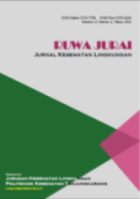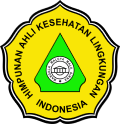Effects of Frangipani Flower Extract (<em>Plumeria acuminata</em> L.) Against the Mortality of <em>Aedes aegypti</em> Larvae
DOI:
https://doi.org/10.26630/rj.v18i1.4513Keywords:
Aedes aegypti, Concentration, Contact time, Larvae, Plumeria acuminataAbstract
Bioinsecticide development has become a demand after the adverse effects of long-term use of synthetic chemical insecticides, including vector resistance and environmental pollution. In particular, this study investigated the ability of Frangipani flower extract (Plumeria acuminata L.) as larvacidal against Aedes aegypti instar III. The study used a Factorial Completely Randomized Design (two replications), conducted on March-May 2023. Plant extraction by maceration using 96% ethanol solvent. Bioassay tests were carried out at three concentration levels (5%, 7%, 10%) and four levels of contact time (6, 12, 18, 24 hours), with 25 larvae in each treatment. Spectrophotometry methods measured flavonoid and saponin content. The two-way ANOVA test analyzed data, the Tukey test, and the probit test to obtain LC50 and LC90. The study found flavonoid and saponin content of 4.43 Mg QE/g and 2.45%, respectively. The lowest total mortality (24 hours after exposure) of Aedes aegypti larvae was at a concentration of 5% (MR= 58%) and highest at concentrations of 7% and 10% (MR= 100%). The 7% concentration is the best performance as a larvicide. Statistical analysis showed differences in mortality based on concentration (P = 0.0001) and contact time (P = 0.0001). Mortality of larvae was caused by damage to the respiratory and digestive systems, as seen from the lateral hair, siphon, and abdomen condition. The results of the probit test obtained LC50 and LC90 of 4.85% (4.36–5.10%) and 5.86% (5.49-7.20%), respectively. The study has proven that Plumeria acuminata L. flower extract has the potential as a biolarvaside against Aedes aegypti, with a mortality effect reaching 100% after 24 hours of exposure.
References
Adibah, A., & Dharmana, E. (2017). Larvicidal Effectiveness Test of Boiled Betle Leaf (Piper betle L.) Against Aedes aegypti Larvae : Studies in Value of LC50, LT50, and The Rate of Larvae Mortality. Diponegoro Medical Journal, 6(2), 244–252.
Adnyani Suari, L. G. S., Haq, A. D., & Rahayu, L. A. D. (2021). Potensi Ekstrak Bunga Kamboja (Plumeria sp.) dan Bunga Kluwih (Artocarpus camansi) Sebagai Biolarvasida Nyamuk Anopheles sp. Dalam Upaya Pencegahan Penyakit Malaria. JIMKI: Jurnal Ilmiah Mahasiswa Kedokteran Indonesia, 8(3), 137–145. https://doi.org/10.53366/jimki.v8i3.267
Ahdiyah, I., & Purwani, I. I. (2015). Pengaruh Ekstrak Daun Mangkokan (Nathopanax scutellarium) Sebagai Larvasida Nyamuk Culex sp. Jurnal Sains Dan Seni ITS, 4(2), 33–36. https://doi.org/http://dx.doi.org/10.12962/j23373520.v4i2.10804
Ahmad, A., & Adriyanto, A. (2019). Efektivitas Serbuk Biji Pepaya (Carica papaya L.) Terhadap Kematian Jentik (Larva) Culex sp. Jurnal Medikes (Media Informasi Kesehatan), 6(1), 104–112. https://doi.org/10.36743/medikes.v6i1.186
Ahyanti, M., & Yushananta, P. (2022). Kombinasi Ekstrak Daun Tapak Dara (Catharanthus roseus) dan Daun Sirsak (Annona muricata) Sebagai Bio-Larvasida. Ruwa Jurai: Jurnal Kesehatan Lingkungan, 16(3), 113. https://doi.org/10.26630/rj.v16i3.3611
Ahyanti, M., & Yushananta, P. (2023a). Kandungan Saponin dan Flavonoid Pada Tanaman Pekarangan Serta Potensinya Sebagai Bioinsektisida Lalat Rumah (Musca domestica). Ruwa Jurai: Jurnal Kesehatan Lingkungan, 17(1), 31. https://doi.org/10.26630/rj.v17i1.3763
Ahyanti, M., & Yushananta, P. (2023b). Formulation, Dosage, and Exposure Time of Natural Substances in Controlling Aedes aegypti Larvae. Poltekita : Jurnal Ilmu Kesehatan, 17(3), 783–791. https://doi.org/10.33860/jik.v17i3.3353
Ahyanti, M., Yushananta, P., & Usman, S. (2022). Efektifitas Beberapa Tanaman dalam Mengendalikan Lalat Rumah (Musca domestica). Poltekita: Jurnal Ilmu Kesehatan, 15(4), 398–402. https://doi.org/10.33860/jik.v15i4.757
Ahyanti, M., Yushananta, P., & Usman, S. (2023). Potential of Some Plants as Bioinsecticides of the House Fly (Musca domestica). The 1st UMSurabaya Multidisciplinary International Conference 2021 (MICon 2021), 1020–1026. https://doi.org/10.2991/978-2-38476-022-0_113
Amutha, V., Deepak, P., Kamaraj, C., Balasubramani, G., Aiswarya, D., Arul, D., Santhanam, P., Ballamurugan, A. M., & Perumal, P. (2019). Mosquito-Larvicidal Potential of Metal and Oxide nanoparticles Synthesized from Aqueous Extract of the Seagrass, Cymodocea serrulata. Journal of Cluster Science, 30(3), 797–812. https://doi.org/10.1007/s10876-019-01542-7
Attasih, M., Pambudi, D. B., & Sa, M. (2024). Determination of Total Phenolic, Flavonoid Contents, and Antioxidant Activity Evaluation of Ethanolic Extract From Plumeria alba. Journal of Nutraceuticals and Herbal Medicine, 5(1), 14–27. https://doi.org/10.23917/jnhm.v5i1.3700
Bej, S., Ghosh, K., Chatterjee, A., & Saha, N. C. (2021). Assessment of biochemical, hematological and behavioral biomarkers of Cyprinus carpio on exposure to a type-II pyrethroid insecticide Alpha-cypermethrin. Environmental Toxicology and Pharmacology, 87, 103717. https://doi.org/10.1016/j.etap.2021.103717
Benelli, G., & Beier, J. C. (2017). Current vector control challenges in the fight against malaria. Acta Tropica, 174, 91–96. https://doi.org/10.1016/j.actatropica.2017.06.028
Bilal, H., Sahar, S., & Din, S. (2017). Bio-Pesticides: New Tool for the Control of Aedes (Stegomyia) albopictus (Culicidae: Diptera) in Pakistan. Journal of Arthropod-Borne Diseases, 11(2), 278–285. http://www.ncbi.nlm.nih.gov/pubmed/29062852
Chaieb, I. (2017). Saponins as Insecticides : A Review. Journal of Plant. Protection, 5(1), 39–50. http://www.tjpp.tn/SiteWeb/PreviousIssues/TJPP5-1/4Ikbal.pdf
Duguma, D., Ortiz, S. L., Lin, Y., Wilson, P. C., & Walton, W. E. (2017). Effects of a larval mosquito biopesticide and Culex larvae on a freshwater nanophytoplankton (Selenastrum capricornatum) under axenic conditions. Journal of Vector Ecology, 42(1), 51–59. https://doi.org/10.1111/jvec.12239
Fikayuniar, L., Rahma, A. D., Wahyuni, A., Shafira, K., Ilham, R. N., Wulandari, S. A., & Khasanah, Y. (2023). Kandungan Flavonoid Pada Ekstrak Bunga Kamboja (Plumeria Sp) Dengan Metode Skrining Fitokimia: Review Artikel. Jurnal Ilmiah Wahana Pendidikan, 9(16), 509–516. https://doi.org/https://doi.org/10.5281/zenodo.8248032
Govindarajan, M., Rajeswary, M., & Benelli, G. (2016). Chemical composition, toxicity and non-target effects of Pinus kesiya essential oil: An eco-friendly and novel larvicide against malaria, dengue and lymphatic filariasis mosquito vectors. Ecotoxicology and Environmental Safety, 129, 85–90. https://doi.org/10.1016/j.ecoenv.2016.03.007
Hidayati, L., & Suprihatini, S. (2020). Pengaruh Pemberian Ekstrak Biji Mahoni (Swietenia mahagoni) Terhadap Kematian Larva Culex sp. ASPIRATOR - Journal of Vector-Borne Disease Studies, 12(1), 45–52. https://doi.org/10.22435/asp.v12i1.2171
Juariah, S., & Irawan, M. P. (2017). Biolarvasida Ekstrak Etanol Kulit Nanas (Ananans comosus L. Merr) Terhadap Larva Nyamuk Culex sp. Unnes Journal of Public Health, 6(4), 232–236. https://doi.org/10.15294/ujph.v6i4.15842
Kamran, M., Shad, S. A., Binyameen, M., Abbas, N., Anees, M., Shah, R. M., & Hafez, A. M. (2022). Toxicities and Cross-Resistance of Imidacloprid, Acetamiprid, Emamectin Benzoate, Spirotetramat, and Indoxacarb in Field Populations of Culex quinquefasciatus (Diptera: Culicidae). Insects, 13(9), 830. https://doi.org/https://doi.org/10.3390/insects13090830
Kasma, A. Y., Ridjal, A. T. M., & M, R. (2019). Efektivitas Ekstrak Daun Pandan Wangi (Pandanus amaryllifolius) Terhadap Mortalitas Larva Aedes sp dan Anopheles. Jurnal Vektor Penyakit, 13(2), 107–114. https://doi.org/10.22435/vektorp.v13i2.465
Kauffman, E., Payne, A., Franke, M., Schmid, M., Harris, E., & Kramer, L. (2017). Rearing of Culex spp. and Aedes spp. Mosquitoes. Bio-Protocol, 7(17). https://doi.org/10.21769/BioProtoc.2542
Kewa, M. M., Almet, J., & Laut, M. M. (2020). Median Lethal Concentration (LC50) Ekstrak Daun Sirsak (Annona muricata Linn) Terhadap Larva Culex sp di Kota Kupang. Jurnal Kajian Veteriner, 8(2), 147–152. https://doi.org/10.35508/jkv.v8i2.3078
Khan, H. A. A. (2022). An impact assessment of insecticides application on the non-targeted mosquito Aedes albopictus (Skuse) in Punjab rice fields, Pakistan. PeerJ, 10, e13697. https://doi.org/10.7717/peerj.13697
Kim, J.-H., Jeong, S.-H., Kim, S.-Y., Kwon, Y.-S., Hwang, K.-H., Lim, J.-S., & Seo, J.-S. (2021). Bioconcentration and Metabolism of the New Herbicide Methiozolin in Ricefish ( Oryzias latipes ). Journal of Agricultural and Food Chemistry, 69(33), 9536–9544. https://doi.org/10.1021/acs.jafc.1c02621
Kumar, D., Kumar, P., Singh, H., & Agrawal, V. (2020). Biocontrol of mosquito vectors through herbal-derived silver nanoparticles: prospects and challenges. Environmental Science and Pollution Research, 27(21), 25987–26024. https://doi.org/10.1007/s11356-020-08444-6
Nasution, A. N., & Ulina, Y. Y. (2022). Toxicity Test of The Crown of God Stemps (Phaleria macrocarpa (Scheff.) Boerl.) Against Culex sp. Larvae. Jambura Journal of Health Sciences and Research, 4(2), 587–595. https://doi.org/10.35971/jjhsr.v4i2.13943
Nikmah, F., Sulistyani, S., & Hestiningsih, R. (2016). Potensi Ekstrak Bunga Kluwih (Artocarpus altilis Linn) Sebagai Insektisida Terhadap Kematian Nyamuk Aedes aegypti Linn Dengan Metode Elektrik Cair. Jurnal Kesehatan Masyarakat (Undip); Vol 4, No 1 (2016): JANUARI, 4(1), 380–389. https://doi.org/https://doi.org/10.14710/jkm.v4i1.11838
Ningsi, E., Yuniar, N., & Fachlevy, A. (2016). Efektivitas Uji Daya Bunuh Ekstrak Daun Pepaya (Carica papaya L.) Terhadap Larva Nyamuk Anopheles aconitus Donits Dalam Upaya Pencegahan Penyakit Malaria di Daerah Persawahan Desa Lalonggombu Kecamatan Andoolo Kabupaten Konawe Selatan. Jurnal Ilmiah Mahasiswa Kesehatan Masyarakat Unsyiah, 1(3), 183424.
Nuryanti, Y. D., & Haryoto, H. (2023). Aktivitas Antibakteri Ekstrak Etanol Plumeria alba L. dan Plumeria rubra L. Terhadap Staphylococcus aureus dan Escherichia coli. Usadha Journal of Pharmacy, 2(1), 16–26. https://doi.org/10.23917/ujp.v2i1.105
Pavela, R., Maggi, F., Iannarelli, R., & Benelli, G. (2019). Plant extracts for developing mosquito larvicides: From laboratory to the field, with insights on the modes of action. Acta Tropica, 193, 236–271. https://doi.org/10.1016/j.actatropica.2019.01.019
Pratama, S. D., & Yushananta, P. (2021). Efektivitas Ekstrak Kulit Batang Maja (Aegle marmelos L.) Terhadap Kematian Larva Nyamuk Anopheles sp. Ruwa Jurai: Jurnal Kesehatan Lingkungan, 15(2), 67. https://doi.org/10.26630/rj.v15i2.2813
Puspa Sari, M., & Priastini Susilowati, R. (2019). Efektivitas Ekstrak Daun Maja (Aegle marmelos (L) Corr) sebagai Larvasida Aedes aegypti. YARSI Medical Journal, 27(1), 001. https://doi.org/10.33476/jky.v27i1.797
Putri, I. N. A., & Yushananta, P. (2022). Efektivitas Ekstrak Daun Pandan Wangi (Pandanus amaryllifolius) Sebagai Biolarvasida Terhadap Larva Culex sp. Ruwa Jurai: Jurnal Kesehatan Lingkungan, 15(3), 109. https://doi.org/10.26630/rj.v15i3.3067
Ramayanti, I., & Febriani, R. (2016). Uji Efektivitas Larvasida Ekstrak Daun Pepaya (Carica papaya Linn) terhadap Larva Aedes aegypti. Syifa’ MEDIKA: Jurnal Kedokteran Dan Kesehatan, 6(2), 79. https://doi.org/10.32502/sm.v6i2.1383
Rohmah, E. A., Subekti, S., & Rudyanto, M. (2020). Larvicidal Activity and Histopathological Effect of Averrhoa bilimbi Fruit Extract on Aedes aegypti from Surabaya, Indonesia. Journal of Parasitology Research, 2020, 1–5. https://doi.org/10.1155/2020/8866373
Rutuba, C., Sharma, P., & Modi, N. (2021). Preliminary Phytochemical Screening, Quantitative Estimation of Total Phenols, Total Flavonoids and Anti-oxidant Activity of Leaves of Plumeria pudica Jacq Genetic structure analysis of Gum yielding plant View project Evaluation of tourism carrying. Indian Journal of Natural Sciences, 12(67), 32926–32935. www.tnsroindia.org.in
Sari, N. K. Y., Sintia, P. L., Deswiniyanti, N. W., & Permatasari, A. A. A. P. (2023). Aktivitas Antimikroba Infusa dan Ekstrak Bunga Kamboja Putih (Plumeria acuminata) Secara In Vitro. Jurnal Kesehatan Terpadu, 7(1), 19–24. https://jurnal.undhirabali.ac.id/index.php/kesehatan/article/view/2495%0Ahttps://jurnal.undhirabali.ac.id/index.php/kesehatan/article/download/2495/3158
Schlechtriem, C., Fliedner, A., & Schäfers, C. (2012). Determination of lipid content in fish samples from bioaccumulation studies: contributions to the revision of guideline OECD 305. Environmental Sciences Europe, 24(1), 13. https://doi.org/10.1186/2190-4715-24-13
Senthil-Nathan, S. (2020). A Review of Resistance Mechanisms of Synthetic Insecticides and Botanicals, Phytochemicals, and Essential Oils as Alternative Larvicidal Agents Against Mosquitoes. Frontiers in Physiology, 10. https://doi.org/10.3389/fphys.2019.01591
Shofi, M., Suwitasari, F., & Istiqomah, N. (2020). AAktivitas Antioksidan Ekstrak Etanol Kamboja Jepang (Adenium obesum) dan Kamboja Putih (Plumeria acuminata). Al-Kauniyah: Jurnal Biologi, 13(2), 167–178. https://doi.org/10.15408/kauniyah.v13i1.12631
Silalahi, C. N., Tu, W.-C., Chang, N.-T., Singham, G. V., Ahmad, I., & Neoh, K.-B. (2022). Insecticide Resistance Profiles and Synergism of Field Aedes aegypti from Indonesia. PLOS Neglected Tropical Diseases, 16(6), e0010501. https://doi.org/10.1371/journal.pntd.0010501
Smith, L. B., Kasai, S., & Scott, J. G. (2016). Pyrethroid resistance in Aedes aegypti and Aedes albopictus: Important mosquito vectors of human diseases. Pesticide Biochemistry and Physiology, 133, 1–12. https://doi.org/10.1016/j.pestbp.2016.03.005
Sura, J., Dwivedi, S., & Dubey, R. (2018). Pharmacological, phytochemical, and traditional uses of Plumeria alba Linn. an Indian medicinal plant. Journal of Pharmaceutical and BioSciences, 6(1), 1. https://doi.org/10.31555/jpbs/2018/6/1/1-4
Taid, T. C., Rajkhowa, R. C., & Kalita, J. C. (2016). A study on total flavonoids, phenol contents and phytochemical screening of leaves extract of Desmodium caudatum (Thunb.) DC , Streblus aspera Lour. and stem of Plumeria acuminata Ait. Environmentalism, 2(2), 76–89. https://environmentalism.in/web_file/pdf/Env.nlc.5.16.pdf
Utami, I. W., & Cahyati, W. H. (2017). Potensi Ekstrak Daun Kamboja sebagai Insektisida Terhadap Nyamuk Aedes aegypti. Higeia: Journal of Public Health Research and Development, 1(1), 22–28. http://journal.unnes.ac.id/sju/index.php/higeia
Wang, G., Shi, H., Du, Z., Chen, H., Peng, J., & Gao, S. (2017). Bioaccumulation mechanism of organophosphate esters in adult zebrafish ( Danio rerio ). Environmental Pollution, 229, 177–187. https://doi.org/10.1016/j.envpol.2017.05.075
WHO. (2005). Guidelines for laboratory and field testing of mosquito larvicides. In World Health Organization. WHO/CDS/WHOPES/GCDPP. http://whqlibdoc.who.int/hq/2005/WHO_CDS_WHOPES_GCDPP_2005.13.pdf?ua=1
WHO. (2020). Vector-borne diseases. World Health Organization. https://www.who.int/news-room/fact-sheets/detail/vector-borne-diseases
Widyasari, R., Oktaviyeni, F., Maghfirandi, R., Farmasi, A., & Pontianak, Y. (2018). Efektivitas Ekstrak Etanol Kulit Jeruk Manis (Citrus x aurantium L.) Sebagai Larvasida Terhadap Larva Nyamuk Aedes aegypti. Jurnal Insan Farmasi Indonesia, 1(1), 9–18. https://e-jurnal.stikes-isfi.ac.id/index.php/JIFI/article/view/152
Yushananta, P. (2021). Dengue Hemorrhagic Fever and Its Correlation with The Weather Factor In Bandar Lampung City: Study From 2009-2018. Jurnal Aisyah : Jurnal Ilmu Kesehatan, 6(1), 117–126. https://doi.org/10.30604/jika.v6i1.452
Yushananta, P., & Ahyanti, M. (2021). The Effectiveness of Betle Leaf (Piper betle L.) Extract as a Bio- pesticide for Controlled of Houseflies (Musca domestica L.). Open Access Macedonian Journal of Medical Sciences, 9(E), 895–900. https://doi.org/10.3889/oamjms.2021.6886
Zaheer, Z., Konale, A. G., Patel, K. A., Khan, S., & Ahmed, R. Z. (2010). Comparative phytochemical screening of flowers of Plumeria alba and Plumeria rubra. Asian Journal of Pharmaceutical and Clinical Research, 3(4), 88–89. https://www.innovareacademics.in/journal/ajpcr/Vol3Issue4/167.pdf
Downloads
Published
How to Cite
Issue
Section
License
Copyright (c) 2024 Ruwa Jurai: Jurnal Kesehatan Lingkungan

This work is licensed under a Creative Commons Attribution-NonCommercial 4.0 International License.

Ruwa Jurai: Jurnal Kesehatan Lingkungan is licensed under a Creative Commons Attribution-NonCommercial 4.0 International License.
Authors who publish with this journal agree to the following terms:
- Authors retain copyright and grant the journal right of first publication with the work simultaneously licensed under a Creative Commons Attribution-Non Commercial License that allows others to share the work with an acknowledgment of the work's authorship and initial publication in this journal.
- Authors are able to enter into separate, additional contractual arrangements for the non-exclusive distribution of the journal's published version of the work (e.g., post it to an institutional repository or publish it in a book), with an acknowledgment of its initial publication in this journal.
- Authors are permitted and encouraged to post their work online (e.g., in institutional repositories or on their website) prior to and during the submission process, as it can lead to productive exchanges, as well as earlier and greater citation of published work.









